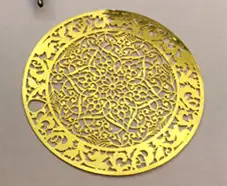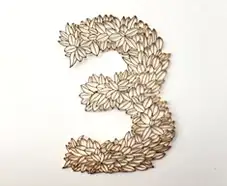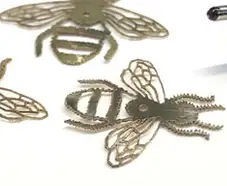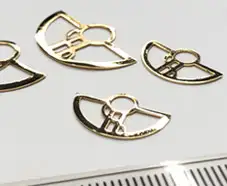- Have any questions?
- +91 9210626626
- info@markolaser.com

Cutting, Drilling, Boring of Metals by Laser Cutting
Laser cutting has established itself as one of the most viable contenders for many applications and has become the most widely used application in micro machining. It competes with the traditional methods of cutting like punch pressing and more recent plasma arc cutting and EDM, but stands out for its ease of fixturing, cutting complex shapes, high rate and low cost for voluminous applications, small kerf, speedy set up and ease of automation. All in all, Laser cutting of materials is a preferred choice on economic and technical aspects. Lasers are used for cutting highly accurate, excellent quality, small kerf width, low or no burr on mild steel, stainless steel, graphite, titanium and aluminum plates for cutting intricate shapes and small holes. The most used application of laser cutting is filigree - for jewelery making.
During cutting of metals by lasers, the large laser beam is focused down to a single pin point, where the heat density is extreme, which results in rapid heating, melting, partial or complete vaporization of the material yielding very precise cuts, holes/ drills on the metal.
Laser cutting of metals is a stable, precise, reliable and a very accurate cutting process depending on the control of the parameters that affect cut quality.
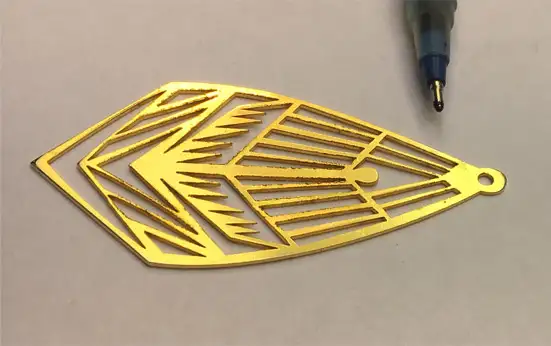
Laser Cutting on Brass Pendant Art
• Object : Leaf Pendant
• Material : Brass
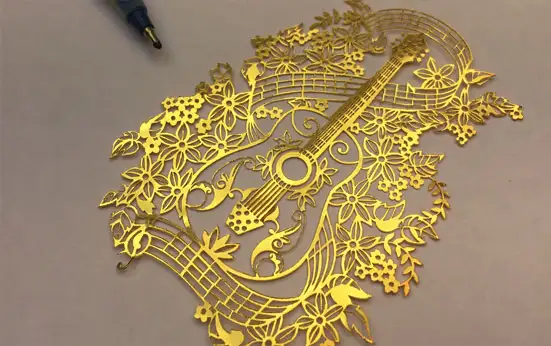
Laser Cutting on Brass Guitar Art
• Object : Guitar Art
• Material : Brass
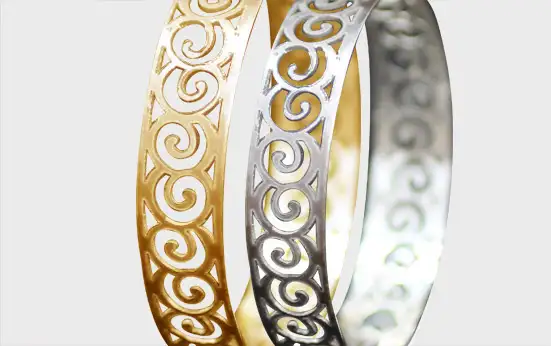
Laser Cutting on Bangle
• Object : Bangle
• Material : Brass
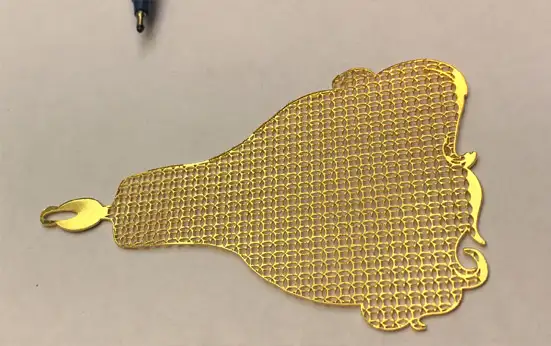
Laser Cutting on Filigree Pendant
• Object : Filigree Pendant
• Material : Brass
What is Laser Cutting?
Laser cutting is a technological process by which metallic and some of the non-metallic materials are cut with extremely great precision as per the requirement. Typically the laser beam diameter is in between 0.1mm and 0.32mm with a power range of 1 to 3 kW, We can set or adjust the power depending on the type of substrate or material and the thickness of the substrate. example like Power range of 6kW is needed to cut through the aluminium (e.g. metals (including reflective metals such as steel, brass, copper and aluminium, tungsten, steel, pewter and titanium etc ), gemstones (e.g. diamonds), ceramics, graphic composites, silicon and many types of plastics). laser cutting simply involves the use of pulsed or continuous wave of the focused laser beam which cut a wide range of substrates with higher-level of accuracy, which is highly repeatable.
From simple to the most complex, awkward and intricate shapes can be precisely cut with fibre laser machine where the user has complete control over the beam intensity. laser cutting is very similar to other laser-based methods such as drilling and deep engraving. In those processes also focused laser beam is used to make the design into a metal or composite.
Types of Laser Cutting
Depending on the application of the laser cutter a selection of different gases are used in conjunction with the cutting. For general boring, cutting and engraving then CO2 is typically used. If high powered laser pulses are used then neodymium (Nd) gas is required, this set up is mainly associated with boring. For a constant high powered beam neodymium yttrium-aluminium-garnet (Nd-YAG) is used. On the bases of application of the laser cutting different gases are used for laser cutting. For simple cutting or boring CO2 is typically used. If we are using high power then neodymium (Nd) gas is used. For the concentrated high power laser source neodymium yttrium-aluminium-garnet (Nd-YAG) is required.
Gaseous laser cutting always needs an electrical current pumped through the gas which gives the laser its cutting characteristics, however, this has recently been revised and RF energy is now preferred as this method does not require the use of electrodes like the DC current does. These electrodes were susceptible to erosion.
Types of Laser Cutting

Laser cutting can cut through different types of metals, non-metals, polymers or any substrates. Non-metals like acrylic, wood, paper and foam core to high carbon and metal like stainless steels. Laser cutting is not best suited to metals example aluminium and copper alloys as they have light-reflective properties and a good conductor of heat, these materials require the use of high powerful wattage of the laser. Laser cutting machines are generally best suited and allowed to thin materials of thickness less than 12mm but can cut through materials around 25mm.
Advantages
Computer and the Marko-controller is used to point and focus with great precision which helps laser cutting very sharp and accurate, there is also no wear in a laser while it is cutting as there is with more conventional methods, such as milling. There is very less chance of warping the metal while the laser is cutting as laser only generates heat in a very small area in comparison with plasma cutting.
At the time of laser cutting, there is no physical damage as mechanical force is not applied.

